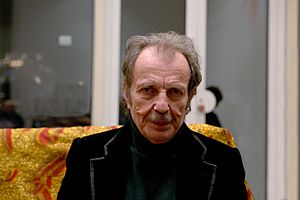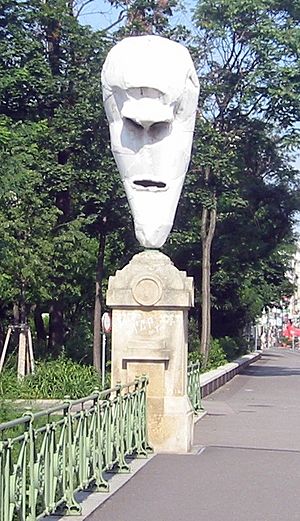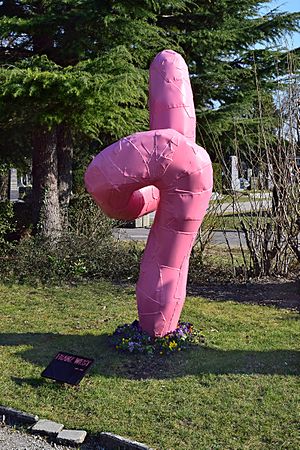Franz West facts for kids
Quick facts for kids
Franz West
|
|
|---|---|

Franz West (2009)
|
|
| Born | 16 February 1947 |
| Died | 26 July 2012 (aged 65) Vienna, Austria
|
| Education | Academy of Fine Arts Vienna |
| Known for | |
|
Notable work
|
The Ego and the Id |
| Movement | Contemporary art |
| Spouse(s) | Tamuna Sirbiladze |
| Awards | Otto Mauer-Preis (1986), Skulpturenpreis der Generali Foundation (1993), Wolfgang-Hahn-Preis, Museum Ludwig (1998) |

Franz West (born February 16, 1947, died July 25, 2012) was a famous artist from Austria. He was known for making unique sculptures, art setups, and even furniture. His art often invited people to interact with it, making them part of the artwork!
Contents
Early Life and Art School
Franz West was born in Vienna, Austria, on February 16, 1947. His father sold coal, and his mother was a dentist. His mother often took him on trips to Italy to see art. Franz West did not start studying art seriously until he was 26 years old. From 1977 to 1983, he studied at the Academy of Fine Arts Vienna. His teacher there was Bruno Gironcoli.
Franz West's Artworks
West began making drawings around 1970. Later, he started creating collages using magazine pictures. These collages showed the influence of Pop Art. His art style began as a response to the Viennese Actionism movement. His work has been shown in museums and galleries for over 30 years. For more than two decades, his art was often featured in major art shows. These included Documenta and the Venice Biennale.
West's art was usually made from everyday materials. He used things like plaster, papier-mâché, wire, polyester, and aluminium. He first made paintings, but then he moved on to collages and sculptures. He also created special portable sculptures called "Adaptives" or "Fitting Pieces." He made art for specific places, known as environments, and even furniture. This furniture included "welded metal chairs and divans." Some of these were lightly padded and covered in plain linen.
For his early sculptures, West often covered ordinary items. He used bottles, machine parts, and furniture pieces. He also covered other unidentifiable objects. He wrapped them in gauze and plaster. This created "lumpy, grungy, dirty-white objects."
In the late 1990s, West started making large sculptures from lacquered aluminum. The first of these, and several others, were inspired by the shapes of Viennese sausages. They also took ideas from his "Adaptives" pieces. These works had single colors and uneven, patchwork surfaces. They were also designed so people could sit or lie on them.
It doesn't matter what the art looks like but how it's used.
Franz West
The Baltimore Museum of Art held the first major show of Franz West's art in the U.S. This show included his newest artwork, The Igo and the Id. He designed this piece specifically for the Baltimore Museum of Art. It has two groups of crumpled, ribbon-like loops that stand about 20 feet tall. One loop is bright pink. The other is painted neatly in blocks of green, yellow, blue, and orange. Both loops have round stools coming out from their lower parts.
For the 2009/2010 season, Franz West designed a huge picture for the Vienna State Opera. This picture was 176 square meters (about 1,894 square feet). It was part of an art series called "Safety Curtain." This series was put together by museum in progress.
Throughout his career, West worked with other artists. He collaborated with Bernhard Cella, Douglas Gordon, and musician Fred Jellinek. He also worked with furniture maker Mathis Esterhazy. Another artist he worked with was Tamuna Sirbiladze, who later became his wife. In 2012, West worked with artist Anselm Reyle. They created a series of furniture sculptures together.
Adaptives: Art You Can Use
Around 1980, West began making "Adaptives." These were plaster objects, usually a few feet long. They were made to be placed over the face, worn around the waist, or held in the crook of the neck. They might look like masks or props for a play. However, their shapes were often unclear. Even when West's objects looked like real things, they remained abstract. People could wear these pieces on the street. They could also carry them like a partner in a joyful, self-focused dance. When someone wore them, they looked both protected and also a bit stuck. His friend Reinhard Priessnitz called these "Passstücke." This was first translated as "Fitting pieces." But West preferred another translation: "Adaptives."
Exhibitions
Franz West's art has been shown in many places around the world:
- 1987 Wiener Secession, Vienna
- 1988 Kunsthalle Bern, Bern
- 1988 Kunsthistorisches Museum, Vienna
- 1988 P.S.1, New York
- 1990 Venice Biennale, Austrian Pavilion, Venice
- 1991 Villa Arson, Nice
- 1994 Museum of Contemporary Art, Los Angeles
- 1996 Museum moderner Kunst, Stiftung Ludwig Wien, 20er Haus, Vienna
- 1997 Fundaçao de Serralves, Porto
- 1997 Museum of Modern Art, New York
- 1998 Middelheim Open Air Sculpture Museum, Antwerpen
- 2000 Museum für Neue Kunst - ZKM Karlsruhe, Karlsruhe
- 2000 Renaissance Society, Chicago
- 2001 Museum für angewandte Kunst Wien, Vienna
- 2001 Deichtorhallen, Hamburg
- 2002 Musée d'Art Contemporain (MAC), Marseille
- 2002/03 Massachusetts Museum of Contemporary Art, North Adams, MA
- 2003 Kunsthaus Bregenz, Bregenz
- 2003 Whitechapel Art Gallery, London
- 2007 Werkstadt Graz, Graz
- 2008 Museum für angewandte Kunst Wien, Vienna
- 2008 Baltimore Museum of Art, Baltimore
- 2009 Los Angeles County Museum of Art, Los Angeles
- 2009 Fondation Beyeler, Basel
- 2009/10 Museum Ludwig, Cologne
- 2010 Museo MADRE, Neapel
- 2010/11 Kunsthaus Graz, Graz
- 2013 MUMOK, Vienna
- 2013 Inverleith House, Royal Botanic Garden Edinburgh, Edinburgh
- 2013 MMK Museum für Moderne Kunst, Frankfurt am Main
- 2014 Williams College Museum of Art, Williamstown, USA
- 2014 The Hepworth Wakefield, Wakefield
- 2016 21er Haus, Vienna
- 2017 Viva Arte Viva, The 57th Venice Biennale, Venice, Italy
- 2018/19 Centre Georges Pompidou, Paris, and Tate Modern, London
Awards and Honors
Franz West received many awards for his art, including:
- 1986: Otto Mauer Prize, Vienna
- 1988: City of Vienna Prize for Visual Arts
- 1993: Sculpture Award at the Generali Foundation
- 1998: Wolfgang-Hahn-Preis, Museum Ludwig, Cologne
- 2011: Golden Lion for Lifetime Achievement, Venice Biennale
- 2011: Austrian Decoration for Science and Art
Personal Life
Franz West was married to Tamuna Sirbiladze, who was also an artist from Georgia. They had two children together.
Images for kids
See also
 In Spanish: Franz West para niños
In Spanish: Franz West para niños




